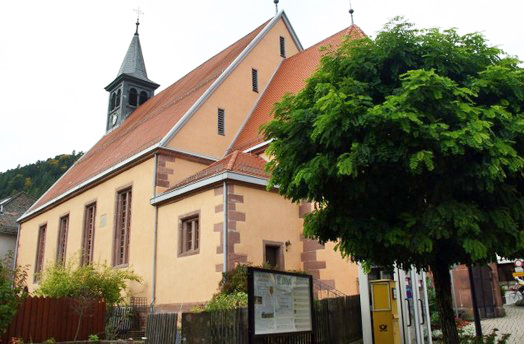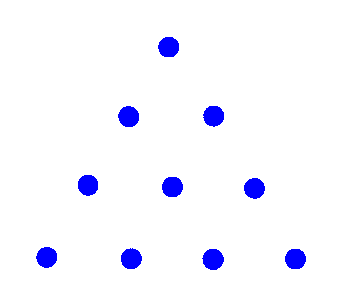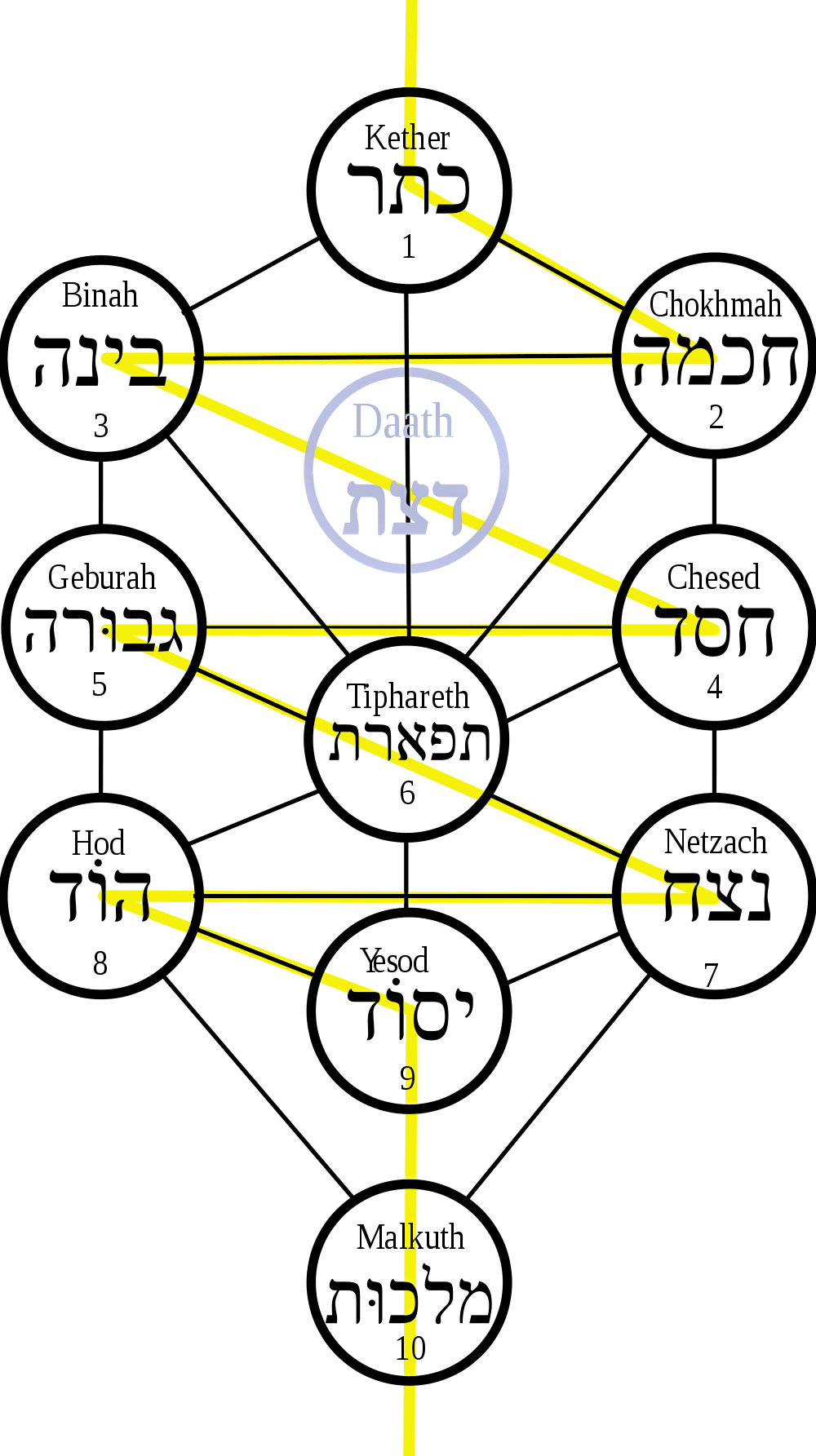|
The Kabbalah
The modern term "Kabbalah"
is from the Medieval Latin word cabala which,
in turn, is from the Hebrew word qabbālâ. This
term, in Hebrew, means a received doctrine or tradition and derives from
the word qibbēl - to receive. There are
approximately two dozen variant spellings of "Kabbalah" the most common of which
include kabbalah, kabala, kabalah, qabalah, qabala, cabala, cabbala, kaballah,
kabbala, kaballah, and qabbalah. This sort of multiplicity is
frequently seen with Hebrew words borrowed into English because there exist
several different systems of transliterating the Hebrew alphabet into Roman
letters. The fact that the Hebrew alphabet does not as a rule indicate short
vowels or the doubling of consonants compounds the difficulties. Spelling
"Kabbalah" with either one or two b's are equally correct, insofar as the
single b accurately reproduces the spelling of the Hebrew, while the
double b represents the fact that it was once pronounced with a double
b. At this website, the spelling "Kabbalah" will be used throughout.
The underlying philosophy
of the Jewish Kabbalah is essentially Neoplatonic in origin. Neoplatonists
believe that the phenomenal world and the human soul were produced by a process
of emanation from the highest level of Reality - the First Hypostasis - otherwise known as "The
One'". This belief system includes practical
techniques designed to enable an individual soul to retrace the path of
emanation in reverse, literally an ascent, or return back to the original
condition of being. Emanation is an ancient way of explaining how our physical
world, which contains a chaotic diversity of entities, can have an underlying
order and a connection with a single, unified source of all being.
The most important proponents of the concept
of emanation as a theory to explain the nature of existence is the ancient Greek
philosopher
Plato
(427-347 B.C.) and his successors, most notably
Plotinus (205-270
A.D.),
Porphyry
(235-305 A.D.),
Iamblichus (245-325 A.D.), and
Proclus (410-485
A.D.). Emanation bridges the distance between "The One" (or "The Good") and the
diversity of existence found in the material world by postulating intermediate
levels of being. There are many different elaborations of this idea; perhaps the most detailed and complete expositions of the
Platonic view is described in
The Elements of Theology
by Proclus. It should also be noted
that this Neoplatonic idea system was closely mirrored in the philosophy of the
17th century Dutch philosopher, Baruch Spinoza (1632-1677).
Spinoza, a descendant of Portuguese Jews, is believed by many scholars to
have been strongly influenced by Kabbalism. Spinoza's philosophy was extremely influential
on many later European philosophers.
Such mystical beliefs and practices were
fairly commonplace among the Gnostics in the Roman Empire of Late Antiquity and
this form of mysticism had adherents, not only among Jews, but among Christians
and Pagans as well. In Europe, after the fall of the Western Roman Empire,
believers in such a system greatly diminished in numbers and went underground,
but they did not entirely die out. During the Renaissance, this belief system
was revived and played a temporary but important (although sometimes
underground) role in European culture until the mid-17th century, when the
system began to be overshadowed by the rise of secular Materialism. In later
centuries, down to the present day, this belief system has continued to enjoy a
small group of adherents who are now, in North America and Europe, classified as
members of the so-called "New Age" community.
It should be clearly understood that most
elements of the Neoplatonic belief system have been and are now rejected as
being heretical by the mainstream, orthodox groups in Judaism, Christianity
(both Roman Catholic and Protestant), and Islam. However, certain mystical
groups in all three of these religions, e.g., Kabbalists among the Jews,
Rosicrucians among the Christians and Sufis among the Moslems, embrace most if
not all of the Neoplatonic beliefs espoused by the great philosophers of Late
Antiquity, i.e., Plotinus, Iamblichus and Proclus.
Although Jewish
emanational mysticism may be dated back
to Late Antiquity, the actual practice of the Kabbalah is much more recent. The
most important Jewish scholar of the Kabbalah,
Gershom Scholem
(1897-1982), has concluded that the Kabbalah originated in Medieval Europe in the 12th
and 13th centuries. The
earliest identifiable centers of this practice were in the Provence region of
southern France, and northern Spain. These regions enjoyed a high culture at that
time, and were much stimulated by contact with the Arab world, both through
Moorish (southern) Spain, and also because the Crusades had caused large numbers of
Europeans to visit Palestine. For Scholem, Kabbalism is based upon a book
entitled the
Zohar, a pseudo-epigraphic commentary on the
Hebrew Torah. Modern scholars believe that the Zohar was written by the Spanish Kabbalist,
Moses of Leon
(ca. 1250-1305), in the
late 13th century. The essence of the Jewish Kabbalah is
comprehension of the divine, both intellectually and experientially, and as such
it presupposes a personal God. The situation in Jewish Kabbalah is clear: the God of
Kabbalah is the God of Judaism, and as such Kabbalah, although unorthodox, is
intended to be an extension and
elaboration of Judaism.
Jewish Kabbalah
As previously mentioned, several key
concepts in Kabbalah owe a
great deal to Gnosticism and Neoplatonism. The outlines of Gnostic and Platonic influences can be
discerned and have been documented by scholars. Kabbalah is strongly emanationist. Emanationism in Kabbalah is expressed primarily through two
metaphors: "Four Worlds" and "Ten Sephiroth." The Kabbalistic Four Worlds are
shown in the following diagram and compared to the equivalent Neoplatonic
structure:
|
Four Worlds of the Kabbalah |
Neoplatonic Levels of Reality |
|
|
|
|
Atziluth - Archetypal World of Pure
Divinity |
"The
One" or "The Good" |
|
Briah - Archangelic
Creative World |
The
Intelligible (Nous) |
|
Yetzirah - Angelic
Formative World |
World Soul |
|
Assiah - Material
World of Man and Animals |
Physical World and Individual Souls |
The Sephiroth is a
grouping of 10 "enumerations" or emanations through which God (referred to as "Ein
Sof" - The Infinite) reveals himself and continuously creates both the physical
realm and the chain of higher metaphysical realms. The doctrine of the Sephiroth
is the essence of the Kabbalah and distinguishes it from other forms of Jewish
mysticism. The ten stage Sephiroth (in the singular each stage is called a
Sephirah) is quite similar to the Pythagorean/Platonic
concept of the "Holy Tetraktys." The Holy Tetraktys explains the creative
process in terms of the first ten numbers; this concept has first been attributed to
Pythagoras
(569-475 B.C.). According to the philosopher Iamblichus,
Pythagoras spent 22 years studying in Egypt and subsequently spent 12 years in
Babylon whereby he acquired most of the esoteric knowledge of both those
societies. By Roman times, the Pythagorean tradition ran in parallel with the teachings
of Plato, and often overlapped, so that it is sometimes hard to distinguish
between Platonism and Pythagoreanism. Many prominent Platonists, such as Iamblichus,
regarded themselves as inheritors of the Pythagorean wisdom tradition, and
believed that Plato derived many of his teachings from Pythagorean sources. I
will first briefly explain the Tetraktys concept and then compare it to the
Sephiroth tradition.
Holy Tetraktys
The number 10, depicted in Pythagorean
fashion, is a triangular configuration of 10 pebbles (see above) that was given
the impressive name "Holy Tetraktys." This method of displaying the number 10 as
the sum of the numbers 1 + 2 + 3 + 4 presents the Pythagorean idea that the
number 10 contained within itself the numbers 1, 2, 3 and 4. Each of these
numbers represented a fundamental idea concerning the Pythagorean Cosmos, i.e.,
the natural world (represented by the number 4) and three levels of higher,
unchangeable reality called "hypostases."
In Greek, the word "hypostasis" (υπόσταση) means underlying state or underlying
substance. In other words, beyond the sensory world of visible matter and
detectable energy (the phenomenal world) are three higher, uniquely defined,
levels of existence (the Hypostases); each subsequent Hypostasis is more sublime
than the level which precedes it. The three levels are:
First Hypostasis (represented by the number "1") = named "The Idea of
the Good" by Plato and referred to as "The One" (Hen) by Plotinus;
Second Hypostasis (represented by the number "2") = The Nous (Intellect); and
Third Hypostasis (represented by the number "3") = The World Soul.
Each of these levels is produced from its higher level by a process called
emanation. The three Hypostases are both ultimate ontological realities and
explanatory principles. All Neoplatonists believed that these three Hypostases
were recognized, not only by Plato, but by the entire subsequent Platonic
tradition. Below the level of the World Soul is the phenomenal world as
perceived by the human senses (= Nature = number "4"); unlike the three higher
hypostases, this material world is in a constant state of flux or change.
The Sephiroth and
the Tree of
Life
The oldest philosophical
roots of the Sephiroth of the Kabbalah, diagrammatically expressed in the Tree
of Life, are found in the
Sepher Yetzirah,
a book that has been dated to about 3rd or fourth centuries A.D. - many
centuries later than the original teachings of Pythagoras and
Plato.
A relationship exists
between the emanational beliefs of the Sepher Yetzirah and the Jewish
mystical system described in the 13th century Zohar, that directly gave
rise to the Kabbalah. There are many differences between the Kabbalah and the
system laid down in the Sefer Yetzirah,
but it is the first documented link in the development of the Kabbalistic ideas.
Emanational belief systems,
similar to those expressed in the
Sepher Yetzirah
are still preserved in many Hermetic orders, where training and initiation by
ritual, drama, and internal experience, enable an aspirant to ascend through the
levels of emanation. The Sephiroth depicted on the Kabbalistic Tree of Life (see
above) provide such a scheme, and it is usually overlaid with the historically
older idea of the ascent through the planetary spheres. This dramatic and
(sometimes) spiritual ascent is mirrored in the various Temple grades, which
entitle the holder to positions of greater authority within an Hermetic order.
For example consider the grade system of the
Golden Dawn.
The Sephiroth are arranged in three columns
of circles.
The left column is called the Pillar of Severity. This represents the female side of man and contains three
Sephirah:
Binah (Understanding), Geburah (Severity) and Hod (Splendor). The right column is called the Pillar of Mercy. This represents the male side of man and also contains
three Sephirah: Chokmah (Wisdom), Chesed (Kindness) and Netzach (Victory). The middle pillar is called the Pillar of Equilibrium
and contains four Sephirah: Keter (Crown), Tipereth
(Beauty, Yesod (Foundation) and Malkuth (Kingdom).
The "zigzag" yellow line connecting all the spheres shows the pattern of
descending emanations from "Ein Sof" down to the material world (Malkuth).
Although there are ten Sephiroth, in three cases two Sephiroth are on the same
level. Accordingly, the path of descent/ascent passes through only seven levels!
This scheme is directly equivalent to the Platonic/Pythagorean and Mithraic
ascent/descent through the seven planetary spheres! If you are a Fourth Way
student, this scheme of ascent/descent is also analogous to the "Ray of
Creation" (Cosmic Octave) described by
P. D. Ouspensky in his book In Search
of the Miraculous, chapters 7 and 8.
An additional,
eleventh Sephirah occasionally appears in some Tree of Life diagrams. This
Sephirah, Daath (Abyss), is shown in
the above diagram colored in light blue. Daath
is considered to be the conscious manifestation of the first Sephirah (Kether), thus
conserving the ten categories.
The
Ascent of the soul up to the Godhead would follow the same line of connections
except in reverse. Spiritual ascent may be thought
of as a movement through the
worlds or levels of emanation in which the coverings of impurity that create distance from the
Divine are progressively removed. The descriptive framework of emanation provides many
images, metaphors, concepts and entities which can be utilized to create a program of ascent;
that is, the process can be conceptualized in stages, and the spiritual aspirant attempts to work through
these stages. More detailed information concerning these stages are outside the
scope of this introductory essay; however, an excellent lecture by Colin Low
entitled
Emanation & Ascent in Hermetic
Kabbalah
is available online.
Christian Kabbalah
As noted above, the practice of the Jewish Kabbalah originated during the
twelfth and thirteenth centuries, mainly in the Moslem and Christian kingdoms of
Spain. The Spain of that era was one of unusual religious tolerance.
Unfortunately, such tolerance was short lived and completely came to an end
during the 15th century with the final destruction of the Moslem Kingdom of
Granada and the expulsion of the Jews from Spain in 1492.
The philosophical beginnings of a Christian Kabbalah began with the writings of
of the Spanish Christian mystic,
Ramon Llull (1232-1317); however, there was
little notice of his work outside of Spain. In the late fifteenth century, primarily
to avoid expulsion, many Spanish Jews converted to Christianity. Many of these
people had been practitioners of the Jewish Kabbalah; they sought to modify the
practice to give a distinctly Christian context to the Kabbalistic doctrines.
This movement gained strong support in Italy from the Florentine Platonists, who
believed that the Kabbalah might contain the key to explaining the mystical
secrets of the Roman Catholic faith. This fortuitous convergence resulted in the
foundation of a distinctly Christian Cabala by the Florentine Platonist,
Giovanni Pico della Mirandola (1463-1494). Pico saw in the Kabbalah a link to
Neoplatonist philosophy that might also provide proof of the divinity of Jesus
Christ. Pico’s writings, and subsequently those of the German scholar,
John
Reuchlin (1455-1522), created an interest in Kabbalah that spread throughout the
entire European intellectual community.
In the sixteenth century, the appearance of Kabbalistic texts in Latin
translation further enhanced attempts to draw further parallels between Jewish
mysticism and Christianity. French scholar,
Guillaume Postel
(1510-1581), translated into Latin and published the main Hebrew emanational manuscripts,
Zohar and Sefer Yetzirah, before they were published in
Hebrew. These Latin texts were influential in standardizing the teachings of the
Christian Kabbalists of the 17th and 18th centuries in Europe.
In the 17th century, the main centers for the study of the Christian Kabbalah
moved from Italy to Protestant England and Germany. The theosophical writings of German
mystic, Jacob Boehme (1575-1624), and the Kabbalistic studies by German
Hebraist, Christian Knorr von Rosenroth (1636-1689), greatly enhanced the status
of the practice among Protestant Christians. The German Jesuit scholar,
Athanasius Kirchner (1602-1680), in his monumental work entitled
Oedipus
Aegyptiacus
(published 1652-1654), promoted a syncretic world
view combining Kabbalah, Hermeticism, Orphism and ancient Egyptian
mythology.
"Kabbalistic Tree of Life" by Athanasius
Kircher
The
"Kabbalistic Tree of Life" is an illustration from a book by the
Jesuit scholar, Athanasius Kircher (1601-1680), entitled "Oedipus
Ægyptiacus" (published 1652).
Kircher's version of the "Tree of Life" has been popular among
mystical groups in both Europe and North America. It is the version
that was used by the Hermetic Order of the
Golden Dawn. The layout of the paths, and the association of the
letters to the paths, varies in different versions, but the Golden
Dawn adopted the basic scheme utilized by Kircher with only minor
adjustments.
One interesting feature of Kircher’s version of the Tree of Life is
the way in which the names of the planets are associated with
principles of the Sephiroth. Kircher attributes the lowest Sephirah,
Malkuth, to the Moon, Yesod to Mercury, Hod to Venus, Netzach to
Mars, Tiphareth to the Sun, Geburah to Saturn and Chesed to Jupiter,
so that the planets are not connected with the three highest
Sephiroth. This scheme entails reversing the normal order of Jupiter
and Saturn, placing Saturn between Jupiter and Mars, against
tradition and actual orbit, and the Sun is placed between Saturn and
Mars, which goes against tradition. The Golden Dawn associations are
almost entirely different: Malkuth is associated with Earth and
Yesod with the Moon, Mercury with Hod and Venus with Netzach;
Tiphareth is still attributed to the Sun, but Mars to Geburah,
Chesed is still attributed to Jupiter, but Saturn to Binah. The
Golden Dawn rearrangement means that the planets follow the
‘Babylonian order’ (Moon, Mercury, Venus, Sun, Mars, Jupiter,
Saturn) exactly, but one of the three highest Sephiroth is now given
a planetary association.
Shown at the right are
two versions of the Kircher Sephirot: The first is the Tree of Life
as it originally appeared in Kircher's book with Latin text; the
second version was prepared with English translations of the Latin
text by the 33° Mason, Manly Palmer Hall (1901-1990). |
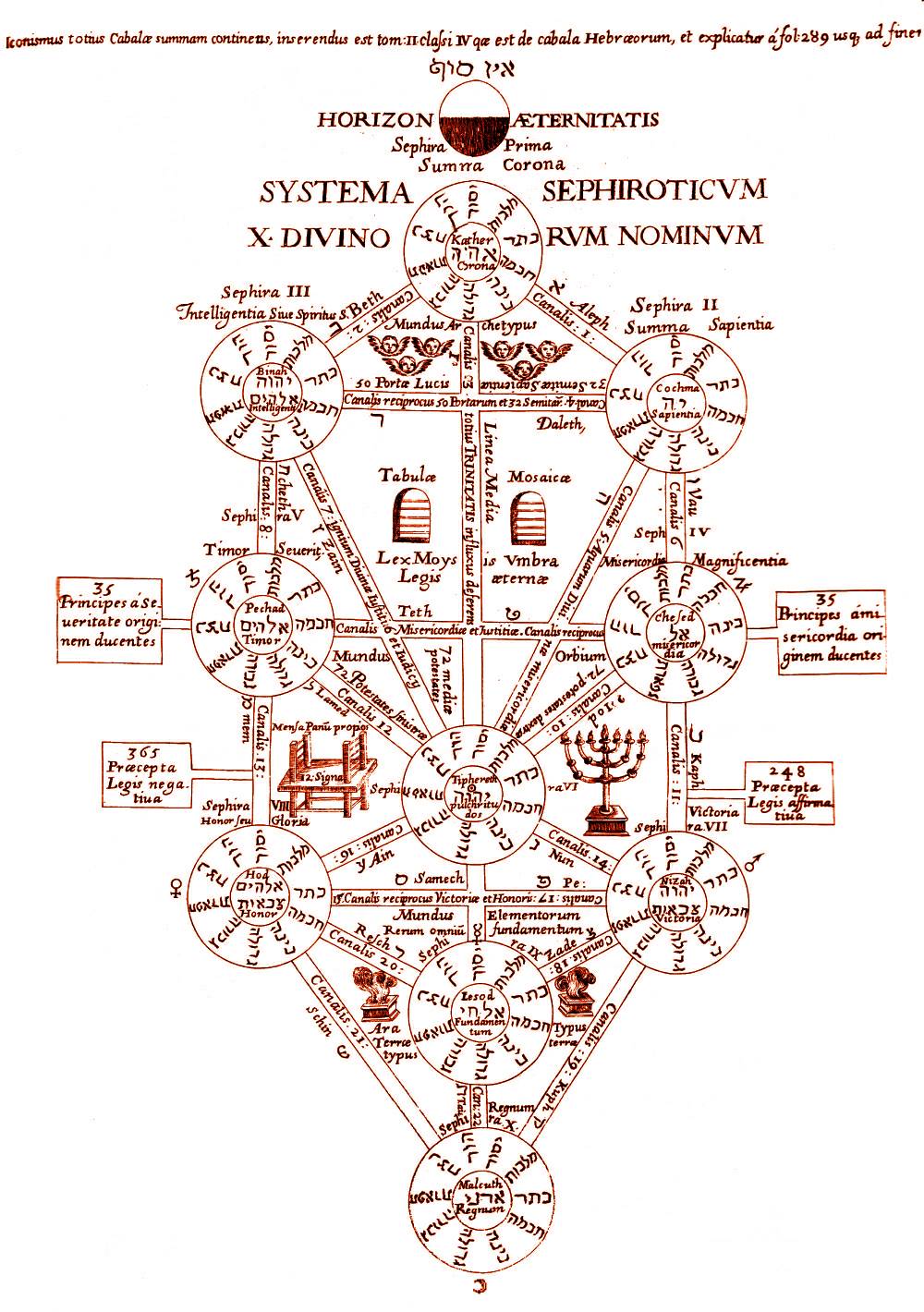 |
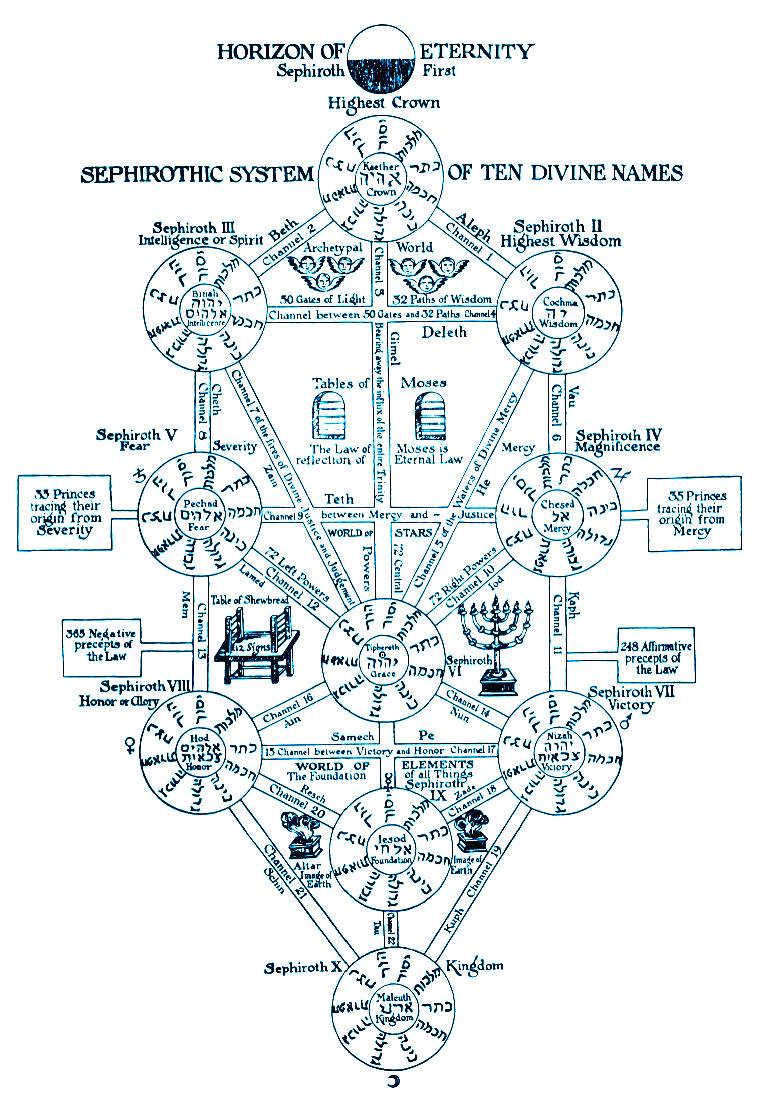 |
Christian Kabbalah reached the final phase of development during the 17th and
18th centuries, when it incorporated alchemical symbolism and Rosicrucian
philosophy. Those who believe, as I do, that Freemasonry is rooted in both
Rosicrucian and Hermetic belief systems, will also see the influence of the
Kabbalah as well.
Concept of the Trinity in the
Christian Kabbalah
In John Reuchlin’s book
entitled, De Arte
Cabbalistica
(published 1517), we find various "proofs" that Christian
doctrines are contained in Jewish texts. One class of proofs
is based upon application of a literary methodology called "notaricon"
- the art of reading Hebrew word forms not as sound cues
pointing to specific meanings, but as graphic statements of
interacting principles. Letters are read as words and
phrases. Notaricon has a rule which says that every first
(or last) letter of every word of a sentence gives a word
that says something about that sentence. Also, one word
could be read as a complete sentence. For example: the first
word of the Hebrew Bible is “BRAShYT.” In
notaricon, the word “BRAShYT” could be understood as an
entire sentence. In Hebrew, the first letters of the
sentence: “In the beginning Elohim saw that Israel would
receive the law.” form the word “BRAShYT” Accordingly, one
could then say that the Bible, in its first word, promises
that the people Israel will receive the Torah. However, a
Christian Cabalist could and would make another sentence for
this same word. For example: “Son, Spirit, Father, their
Trinity, complete oneness.” also can be derived from
“BRAShYT.” Thus, he would say that an important Christian
doctrine is contained in the Jewish Bible!
These word
manipulations seemed to have assisted in convincing recently
"converted" Spanish Jews to embrace this extremely important
tenet of the Christian faith - the Trinity! More should be
said about this concept. As far back as the 13th century
(1292), a Franciscan monk, Arnoldo de Villanova (1235-1315),
said that the fact that there are three different letters in
the
Tetragrammaton (YHWH or in Hebrew:
יהוה) -
the Hebrew word for God - was a sign that God is really a
Trinity. In the 16th and 17th centuries, Christian Cabalists
did their utmost to cite other proofs of the Trinitarian
concept from Jewish texts. Giovanni Pico said that the first
three elements of the Kabbalistic Tree of Life - the
Sephiroth: Kether, Hokhmah, and Binah - actually represent
the Trinity. John Reuchlin referred to God as a threefold
principle of unity and the Venetian monk,
Francesco Giorgi (1466-1540), found the trinity in
the Jewish names for God: 1) AHYA (Eheieh, which Giorgi
identifies with the Father), YHWH (for the son) and ADNY
(Adonai, for the Holy Ghost). Three other Jewish holy names
are folded into a trinity by John Reuchlin: He (He), Eheih
(I am) and Esh (fire).
At the beginning of
this essay, I stated that the Zohar was the most
important document expressing the doctrines of the Jewish
Kabbalah. The following is an excerpt from the
Jewish Encyclopedia (published 1906) article on the
Zohar:
The
enthusiasm felt for the Zohar was shared by many Christian
scholars, such as Pico de Mirandola, Reuchlin,
Ægidius of Viterbo, etc., all of
whom believed that the book contained proofs of the truth of
Christianity. They were led to this belief by the analogies
existing between some of the teachings of the Zohar and
certain of the Christian dogmas, as for instance the fall
and redemption of man, and the dogma of the Trinity, which
is expressed in the Zohar in the following terms:
"The
Ancient of Days has three heads. He reveals himself in three
archetypes, all three forming but one. He is thus symbolized
by the number Three. They are revealed in one another.
[These are:] first, secret, hidden 'Wisdom'; above that the
Holy Ancient One; and above Him the Unknowable One. None
knows what He contains; He is above all conception. He is
therefore called for man 'Non-Existing' [Ayin] (Zohar,
iii. 288b)."
This and also
the other doctrines of Christian tendency that are found in
the Zohar are now known to be much older than Christianity;
but the Christian scholars who were deluded by the
similarity of these teachings to certain Christian dogmas
deemed it their duty to propagate the Zohar. Shortly after
the publication of the work (Mantua and Cremona, 1558)
Joseph de Voisin translated extracts from it which deal with
the soul. He was followed by many others, among whom was
Knorr, Baron von Rosenroth, who rendered into Latin the
introduction, the "Sifra di-Ẓeni'uta," the "Idra Rabbah,"
and the "Idra Zuṭa" ("Kabbala Denudata," Sulzbach, 1677).
My personal view as to the reason
why Jewish mysticism, as expressed in the Zohar
and elsewhere, seems to give credence to a threefold
division of the Godhead is the same reason why the
Christian concept of the Godhead evolved into the
Doctrine of the Trinity. The reason is simple, even
though both religions will vigorously deny it. Jewish
mysticism and Christian higher theology are both based
upon the Neoplatonic philosophy of Late Antiquity as
expressed by Plotinus, Iamblichus, Proclus and others.
These philosophers espoused a basically threefold division of
higher reality - the
Three Hypostases which I briefly discussed in
the first part of this essay. To me, it is quite
understandable that Christian scholars were able to find
expression of beliefs in the Jewish Kabbalah that seemed
to resemble Christianity. Both of these belief systems
were based upon the same philosophical foundation, i.e.,
Neoplatonism!
The number three was
important in the Christian Kabbalah in other ways. They
divided the Cosmos into three divisions: elemental,
celestial, and intelligible. These three can be found in the
Heptaplus of Pico, De Verbo Mirifico of
Reuchlin and De Harmonia Mundi of Giorgi. Giovanni
Pico wrote that the first division, the black pit of
darkness, is the Earth, the intelligible division is the
world of pure light and, in the celestial division, light
and darkness are in perfect balance. The three souls of the
Jews, called nephesh, ruach, and
neshamah , may be compared to the threefold soul of
Renaissance Neoplatonism. Francesco Giorgi wrote about these
three souls in his book De Harmonia Mundi. He
described a high, middle, and lower soul in the long poem
contained in the book. The high soul is the divine soul -
the immortal Neshamah; the middle soul is the
mediator, the breath of life or Ruach; and the
lower soul is the animal soul or nephesh in Hebrew.
|
Christian
Kabbalist at Work? - An Etching by Rembrandt
The German
scholars who inspired the design of the "Lehrtafel of Princess
Antonia" were almost certainly Freemasons and Rosicrucians who were
familiar with the philosophy of the Christian Kabbalah. At left is
an engraving by one of their Dutch contemporaries, Rembrandt van
Rijn (1606-1669): "The Inspired Scholar" (completed
ca, 1652), ink on paper (dry point etching and engraving),
dimensions 21 x 16 cm, print on
display at the Rijksmuseum in Amsterdam.
Rembrandt's title for this very famous engraving is unknown; art
historians have used several names over the centuries. The names most
frequently
used are "Doctor Faustus" or "The Practicing Alchemist." The name I
prefer is the one used by the English Academic, Dame Francis Yates
(1899-1981). She called the engraving "The Inspired Scholar."
The Rijksmuseum describes the engraving in the following words:
"An old man looks up from his work. A bright, radiating disk has
appeared at the window of his study. Within the circle of light is a
mysterious text. It is an anagram - that is, words in which the
letters are in a different order. Reading from the inside out, it
says: INRI ADAM TE DAGERAM AMRTET ALGAR ALGA S TNA, although just what
that means is unclear. To the right of the disk, a hand can be
distinguished, which points to something resembling an oval mirror.
Although the room is poorly lit, many things can still be perceived;
the books, the globe [scientific instrument also known as an
astrolabe], and the skull [just behind the old man's head], all suggest that the man is educated."
Dame Francis Yates (1899-1981), in her book The Occult Philosophy in the
Elizabethan Age (published 1979, provides the following
description:
"The artist who lived near the Jews of Amsterdam and studied them
so deeply shows here a figure who has been immersed in profound
studies, as shown by the globe and other evidences of deep
involvement in science. The melancholy and thoughtful student turns
in surprise to see a vision, rays of light passing through a
circular combination of letters, the central circle marked with the
letters INRI, the monogram of Christ.
"One of the earliest and most persistent interpretations of this
impressive composition is that it represents Faust and is depicting
a profound search for forbidden knowledge. This interpretation is
now generally abandoned; it does not fit with the dignity and
religious intensity of the subject. Further, a discovery was made by
H. van de Waal that the outermost ring of the diagram when read in
reverse, contains the letters AGLA, a formula referring to the
Eighteen Benedictions, recited thrice daily in Jewish liturgy. The
letters AGLA refer to the first words of the Second of the Eighteen
Benedictions: Attah gibbor le-dam Adonai. The vision is
therefore seen now as profoundly religious in content, both
Christian and Jewish. The vague forms glimpsed outside the window
are interpreted as half-seen angels, reflecting the supernal light
into the diagram.
"I would suggest that this etching is related to the subject of
inspired melancholy, ... the student being a Christian Kabbalist to
whom, in the dark night of his melancholic labors, the Divine Name
is revealed."
|
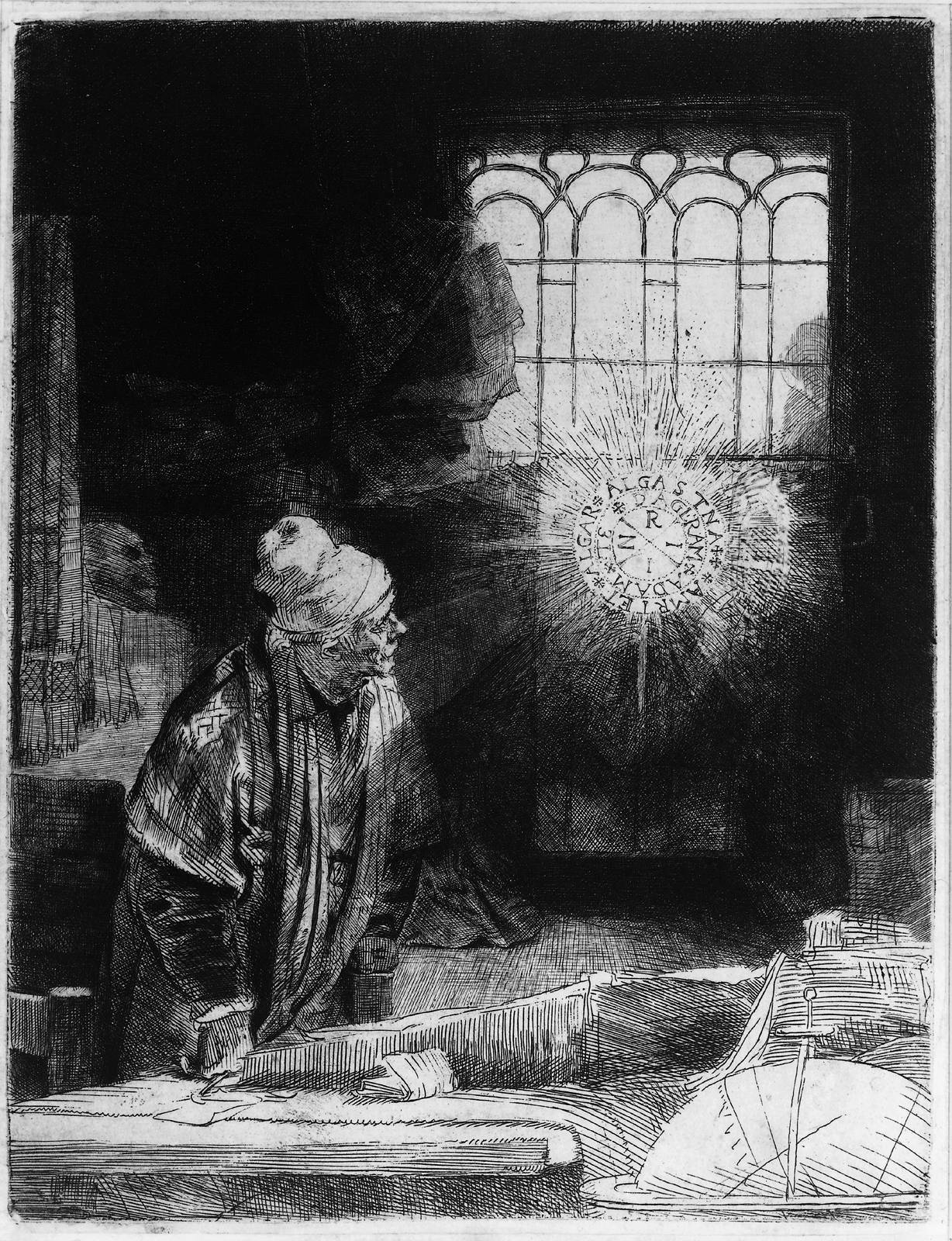
|
Use of the
Christian Kabbalah in the Lehrtafel of Princess Antonia
|
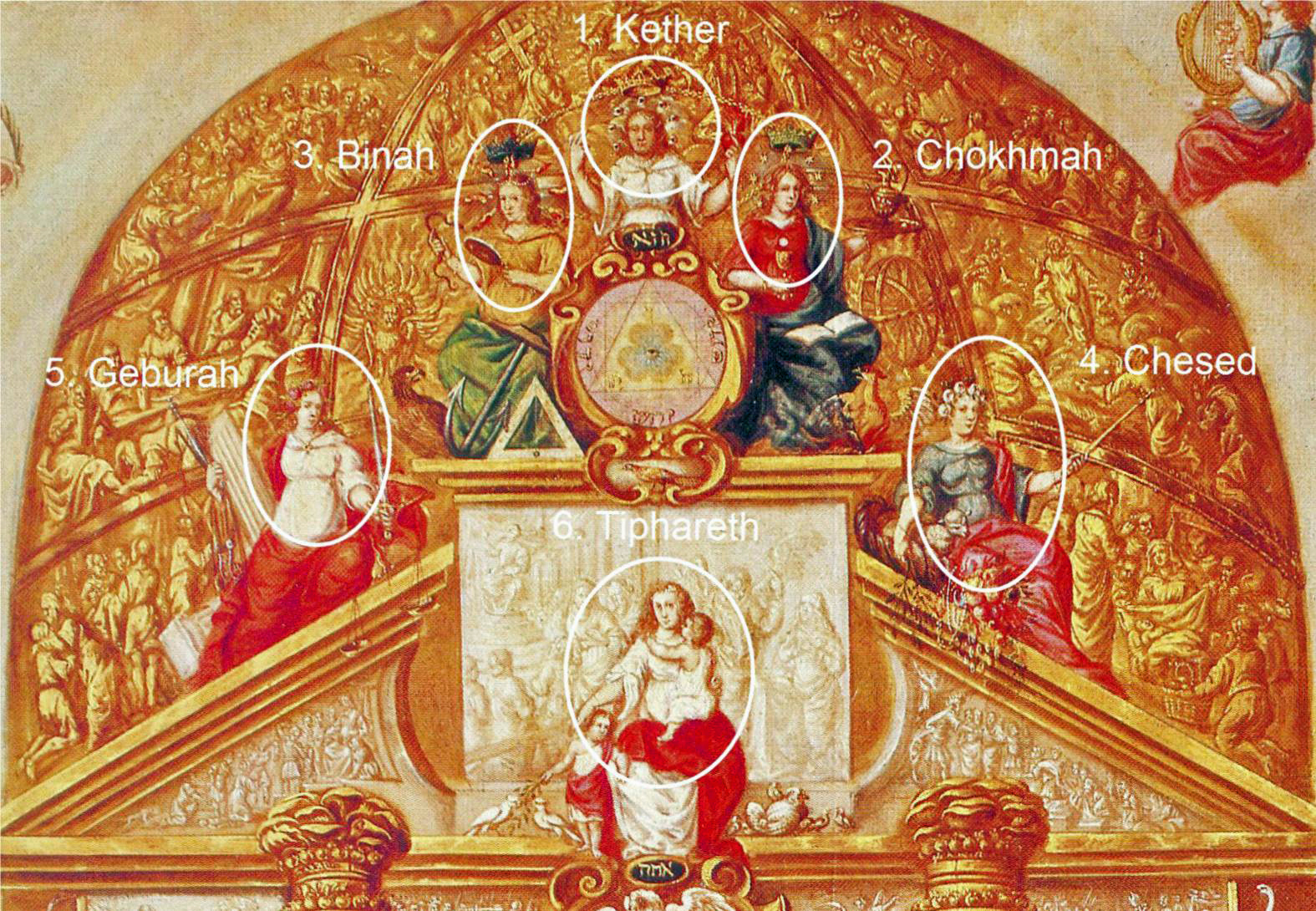 |
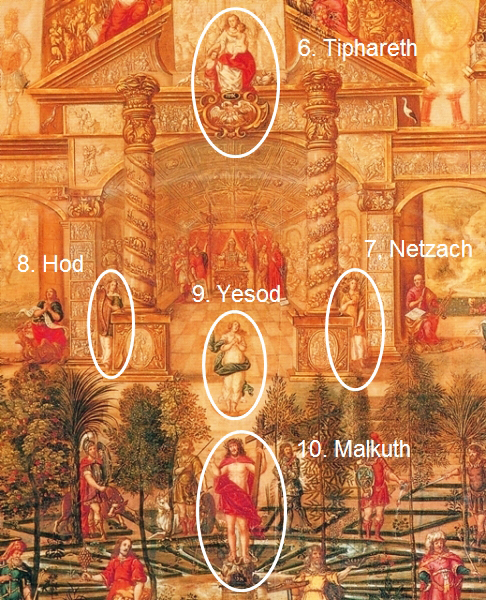 |
|
Portion of Lehrtafel center
panel showing Sephiroth 1 through 6, each indicated by a white oval.
|
Portion
of Lehrtafel center panel showing Sephiroth 6 through 10, each indicated by a white oval. |
The German scholars who inspired the design of the "Lehrtafel of Princess
Antonia" were almost certainly Freemasons and Rosicrucians who were familiar
with the philosophy of the Christian Kabbalah. As shown in the above photograph,
a Kabbalistic "Tree of Life" diagram is hidden within the center panel of the
triptych. The German scholar and theologian,
Otto Betz (1917-2005) has performed
a brilliant analysis of the Kabbalistic elements contained within the Lehrtafel
in his book entitled:
Licht vom unerschaffnen Lichte. Die kabbalistische Lehrtafel der Prinzessin
Antonia. People who are deeply interested in the Christian Kabbalah should
refer to his book; unfortunately, it has never been translated into English. My
elementary discussion of some of the Kabbalistic and other esoteric aspects of the Lehrtafel is given in
the following paragraphs.
The overall design of the
Lehrtafel displays a contrasting yet complementary, twofold structure. This
twofold structure is presented on many different levels of understanding, but
only a single theme is contained within each level. That theme concerns the
positioning of Moses
vis-à-vis Christ. Let me
mention just a few examples:
1) The left panel of the
triptych depicts a scene
from the New Testament concerning the nighttime flight to Egypt by the Holy
Family; the right panel of the triptych depicts a scene from the Old Testament
where Pharaoh's daughter and her entourage find the baby Moses in the bulrushes
alongside the Nile in Egypt. Two different babies, one in each picture - baby Jesus
and baby Moses - but the story concerning each child takes place in Egypt. The
triptych is subtly pointing out that both Moses and Jesus were in
Egypt as children.
2)
The "heart" of the center panel of
the Triptych, depicts the inner sanctum of a great temple (similar to the Temple
of Solomon) in which two crucifixions are shown. This is another juxtaposition
of the Moses and Christ themes. The standard crucifixion of Christ scene is set
alongside a scene involving a crucified serpent, derived from the story of Moses
and the Brazen Serpent (see Numbers, Chapter 21, Verses 4-9). The basic message
conveyed by these two crucifixions is quite clear. Just as an Israelite who had
been bitten by a viper could be purified from the effect of the venom simply by
gazing upon a brazen serpent nailed to a pole, so could a sinner who was
poisoned by his own sins have them purified or washed away by the blood of
Christ who had been nailed to a cross.
3) The Jewish Kabbalah is
Jewish mysticism; the traditional story concerning its origin is that the
Kabbalah is the esoteric, oral teaching of Moses, while the Torah is his
written, exoteric teaching. Conversely, most Christian mystics believe that
their belief system is based upon the secret, oral teaching of Jesus, while the
Gospels contain his written, exoteric teaching.
4) The simple porportion may be used to show the equivalence
between Moses and Jesus and between Jews and Christians. The esoteric Kabbalah
compared to exoteric Judaism is equivalent to esoteric Rosicrucianism compared
to exoteric Protestant Christianity.
5) The Egyptian theme
running through much of the Lehrtafel iconography is there to provide a cryptic
allusion to the Rosicrucian and Masonic belief that the secret, oral teachings
of the ancient Egyptian temple schools were the source not only of the teachings
of Moses but that of Christ as well! There is little scriptural evidence to
support this position, but I am able to make the following comments.
Re Moses:
Exodus Chapter 11, verse 3 states: "And moreover, the Man Moses was exceedingly
important in the land of Egypt." Also, Acts Chapter 7, verse 22 states: "And
Moses was learned in all the wisdom of the Egyptians and was mighty in words and
deeds."
Re Jesus:
There is no scriptural comment concerning the time that Jesus and his family
spent in Egypt. However, certain, mostly oral, alchemical and Gnostic traditions
assert that Jesus, as a young man, studied for a time in Alexandria, which then
had a large Jewish community. Indeed, historians have stated that, in that era, more Jews lived in
Egypt than in Palestine! Jesus is supposed to have been initiated
into the mysteries of the Serapis religion and also into certain other secret
societies. There was and still is a Coptic and Gnostic tradition that Jesus had not only been in
Alexandria, but that he and his family had initially settled in the city of
Leontopolis, at which a Jewish
colony was located; this colony flourished from about 170 B.C until it was
destroyed by order of the Emperor Vespasian in 73 A.D.
Leontopolis
was near the city of Heliopolis which had been one of the greatest centers of
learning among the native Egyptians.
Otto Betz (see above)
believed that the Lehrtafel is intended to show that the pathway to human
salvation, in both the Christian and Jewish understanding, is concerned with the
connections between nature and history, love and suffering, kingship and
service, et al. The Tree of Life, with its ten Sephiroth, helps explain this belief. It is arranged as a stylized tree or as a
pattern of a human figure. The following table compares the ten Sephiroth of the
Jewish Kabbalah with the corresponding Christian Sephiroth depicted in the
Lehrtafel:
|
Hebrew Word |
Meaning in the
Jewish Kabbalah |
Meaning in the
Christian Kabbalah of the Lehrtafel |
Comments |
| |
|
|
|
| 1.
Kether - Conscious Intellect |
1.
Crown |
1. God
the Father |
Christian Trinity
occupies the first 3 Sephiroth |
| 2.
Chokhmah - Conscious Intellect |
2.
Wisdom |
2. God
the Son (Jesus as God) |
|
| 3.
Binah - Conscious Intellect |
3.
Understanding |
3. God
the Holy Spirit |
|
| 4.
Chesed - Primary Emotion |
4.
Kindness |
4.
Mercy |
|
| 5,
Geburah - Primary Emotion |
5.
Severity |
5.
Justice |
|
| 6.
Tiphareth - Primary Emotion |
6.
Beauty |
6. Love |
|
| 7.
Netzach - Secondary Emotion |
7.
Victory |
7.
Victory |
|
| 8. Hod
- Secondary Emotion |
8.
Splendor |
8.
Praise |
|
| 9.
Yesod - Secondary Emotion |
9.
Foundation |
9.
Foundation |
Means a Vessel
which enables one to take action |
| 10.
Malkuth - Secondary Emotion |
10.
Kingdom |
10.
Jesus as Man |
Christ appears
twice as both God and man |
Other than the ninth
Sephirah, all of the principles of the Christian "Tree of Life" differ from the
Jewish version. The ninth Sephirah, called Foundation in English, also can mean
a vehicle or device through which action may be taken; in the Lehrtafel, this
Sephirah has been given a likeness of Princess Antonia herself. I interpret this
to mean that she is expected to perform a major role in the promulgation of the
mystical, emanationist philosophy symbolized in the painting. A major difference
between Jewish and Christian Trees of Life is that the first three Sephiroth
pertain to the Trinity in the Christian version. I find that one of the most
interesting characteristics of the Lehrtafel Tree is that the images
representing seven of the Sephiroth are women; the
only exceptions are Kether (God the Father), Chokhmah (God the Son) and Malkuth
(which is a depiction of Christ as a man holding the Cross).
Kabbalah and the Tarot
In recent times, many "New Age"
practitioners of the Kabbalah do so in conjunction with the use of the Tarot.
I consider this to be a completely spurious approach, if one's goal is the
achievement of higher states of consciousness. Accordingly, I will conclude this
essay with a quote from a recent
interview given by the noted artist and
Tarot expert, Robert M. Place. His words are well expressed and reflect my
sentiments exactly:
In the 1800's, the French occultist
Eliphas Levi was
enamored with the Kabbalah and tried to synthesize all occult teachings into one
Kabbalistic system. He also became interested in the Tarot and for him to make it
part of his synthesis he had to demonstrate that the Tarot was Kabbalistic. He
picked up on an idea that was mentioned before him by
Court de Gebelin,
namely, that the 22 trump cards are related to the 22 letters in the Hebrew
alphabet. The Hebrew letters in the Kabbalistic system are also each related to a
sign of the zodiac, a planet, or an element. So, once the cards are assigned to
the letters, they also are connected to the astrological system.
Many people still find this a
satisfying way to think about the Tarot. But I find it disappointing. The
symbolism of the Hebrew alphabet and the zodiac simply does not fit with the
images that are in the Tarot trumps. Levi force fit it for the sake of his
theory. This system of correspondences leads one away from the symbolism that is
actually presented in the pictures on the cards. It denies the story that is
there. It is based on the false idea that the Tarot was consistent in the number
and ordering of the trumps and that this order is a secret code. At its worst,
this type of thinking reduces the symbols in the Tarot to mere signs and stops
one with interacting with the pictures. It is unlikely that Jewish Kabbalists
would have created a set of icons like the Tarot trumps because they felt that
it was sacrilegious to create icons and the Christian Kabbalah developed almost
a century later than the Tarot.
Some people are enamored with the idea
of unlocking a secret code that will give them mystical insight into the
workings of the universe. However, I think that this not a true mystical quest.
To understand what is in the Tarot, I feel that it is essential to look at its
origins in the Italian Renaissance and study the iconography and symbolism of
that time. They are related to the iconography of the period and depict an
allegorical parade. The Renaissance was a time when the power of symbols and
images was fully recognized. It was part of their attempt to reclaim the ancient
Classical world. This is why the arts flourished in the Renaissance. By
reclaiming the art and wisdom of the ancient world they also reclaimed the
ancient mystical philosophy that was centered on the work of Plato. This is what
we call Neoplatonism and it is this mystical Neoplatonism that is expressed in
the Tarot.
References
The two principal
scholarly works on the Jewish and Christian Kabbalah are as follows:
Jewish Kabbalah:
Gershom Scholem
(1897-1982), Major Trends in Jewish Mysticism (first English edition
1941).
Christian Kabbalah:
Joseph Leon Blau
(1909-1986), The Christian Interpretation of the Cabala in the Renaissance
(1965).
For the purposes
of this short essay, I have used the following sources:
1) Arthur Edward Waite,
The Doctrine
and Literature of the Kabbalah (London: 1902)
2)
Colin Low, Online Article:
Kabbalah - Frequently
Asked Questions (1996).
3) Frances A. Yates, The
Occult Philosophy in the Elizabethan Age (London: 1979).
4) Nicholas Goodricke-Clarke,
The Western Esoteric Traditions (Oxford: 2008).
5) Robert M. Place, The
Tarot - History, Symbolism and Divination (2005). pages 68-73.
6) Rudolf Steiner, The
Secret Storm (2000), pages 206-238.
7)
Otto Betz,
Licht vom unerschaffnen Lichte. Die kabbalistische Lehrtafel der Prinzessin
Antonia (1996).
|
